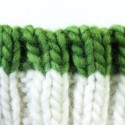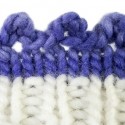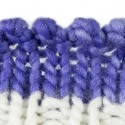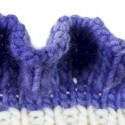Free Video
Even if you’ve run into a lot of frustration with this bind-off before, I want you to put that aside and try this with a fresh, new outlook.
I promise you can do it, because I’m going to show you everything slowly and carefully.
Keeping it simple: There are only two basic movement groups that make up this bind-off, and you say them like a mantra in your mind as you work.
The moves are “knit-off purl” and “purl-off knit,” and I explain them in the video and the photo tutorial below.
About sewn bind-offs and delicate yarn: Any time that you’re using a delicate yarn on a sewn bind-off, you’ll want to be careful not to pull too fast or too tight, because the yarn could break. Just go slow.
To undo this bind-off if you mess up, take the tapestry needle and follow the path of yarn back through the stitches the way you came, putting the stitches back on the needles as you go.
If your bind-off ends up being too loose, use your tapestry needle to pick through the stitches one by one and pull them tighter down the seam to tighten them up. If it’s too tight the best thing would be to take the bind-off out and start over.
Download an illustrated guide to Kitchener Stitch here.
Kitchener Double-Rib Bind-OffPremium Video
The trick to this bind off (and it’s only a little scary) is to take the stitches off the needle and slide them onto two needles – one needle into the knits (which will naturally come forward) and one needle into the purls (which naturally recede).
Then all that remains is to bind off the stitches with Kitchener Stitch (which I show you in this tutorial as well as in its own place in this course).
Take it from me that this technique is about 100 times easier than the Invisible Ribbed Bind-Off for 2×2 Rib.
Picot Point Bind-Off #1Premium Video
Similar bind-offs to this one are the Picot Point Bind-Off #2 and the Picot Hemmed Edge Bind-Off, which both have smaller picots.
Picot Point Bind-Off #2Premium Video
I chose to include this bind-off out of the many picot bind-offs that are out there because these picots are very small and sweet.
This bind-off does tend to flare out and roll forward a bit because of all the picots sitting next to each other.
Blocking the edge will help a little. Soak it in water, squeeze the water out, and lay the bind-off flat. Take your fingers and shape the little picot points so that they lay next to each other as flat as possible.
Ruffle Bind-OffPremium Video
How it works: On the RS row before you want to create the ruffle, you increase drastically across the row (which, by the way, means you’re going to want to use some very pointy knitting needles).
Then you knit a few rows in St st and these rows, being crowded because you’ve increased the number of stitches so much, kind of fold back on each other — that’s what makes the ruffle.
The reason this is considered slow is because of the time it takes to knit the 5 rows in St st before you actually bind off.
This is a bind-off you absolutely must block and shape by hand to make it as ruffled as possible. Get it wet, squeeze the water out, lay it out on a towel, and then use your fingers to pull, widen, and shape each ruffle while the yarn is damp.






